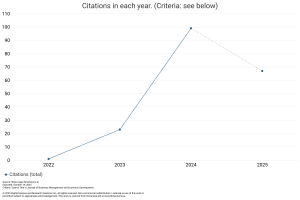Effective Strategies for Human Resource Development in the Digital Era
DOI:
https://doi.org/10.59653/jbmed.v2i03.898Keywords:
Human Resource Development, Digital Era, Technology, Performance ManagementAbstract
The rapid development of digital technology has brought significant changes in various aspects of life, including the field of human resource management (HR). This article aims to identify and analyze effective strategies that can be applied in human resource development in the digital era. In this context, HR development strategies do not only focus on improving technical skills, but also on developing soft skills which are essential for adaptation in a dynamic work environment. This research uses a qualitative approach with a comprehensive literature study method, reviewing various academic and practical sources. relevant to the topic. The main findings of this study show that the integration of technology in the training and development process, the formation of a work culture that supports innovation, and the implementation of a digital-based performance management system are some of the key effective strategies. Apart from that, the importance of visionary and adaptive leadership has also been identified as a determining factor for success in HR development in the digital era. This article provides insight for HR practitioners and managers to formulate HR development policies and programs that are relevant to the demands of the times. In addition, this research also makes a theoretical contribution by offering a conceptual framework for holistic and sustainable human resource development in the digital era.
Downloads
References
Dwi Sulistyo, N., Syukur, M., Nur Hasannah, S., & Saifudin, A. (2023). Strategi Efektif Manajemen Pengetahuan dalam Sistem Informasi Organisasi Berbasis Teknologi Informasi (Vol. 1). https://journal.mediapublikasi.id/index.php/manekin
Fitriani, R. L., Sundari, S. S., Kurnia, N., Lp3i, R. P., & Tasikmalaya, K. (n.d.). THE DIFFERENCES OF LANGUAGE USE BETWEEN MALES AND FEMALES IN SUNDANESE LANGUAGE IN INFORMAL CONVERSATION. In JALL (Journal of Applied Linguistics and Literacy (Vol. 7, Issue 2). https://jurnal.unigal.ac.id/index.php/jall/index
Handa Wijaya, B., Damanuri, A., & Asyiqin, A. D. (n.d.). Model Kinerja Manajamen Sumber Daya Manusia Pada Lembaga Amil Zakat YDSF Malang Di Era Disrupsi Digital. 3(1). https://doi.org/10.21154/joipad.v3i2.6133
Kurnia Romdoni, N., Wirasujatma, M., & Kampus Tasikmalaya, I. (n.d.). Pengaruh Pemberian Kredit Terhadap Return on Assets Pada Perbankan Bumn Tahun 2016-2020.
Oktaviani, R., & Sutarsa, M. (2024). Analysis of Collection Micro, Small and Medium-Sized Enterprises (MSMEs) Receivable on Bank BJB KCP X Customers. Journal of Business Management and Economic Development, 2(02), 912–918. https://doi.org/10.59653/jbmed.v2i02.813
Pengembangan, S., Daya, S., Dalam, M., Tantangan, M., Irawan, D., & Harahap, N. (2023). Human Resource Development Strategies In Facing The Challenges Of The Digital Media Industry In Medan Tribune. In Management Studies and Entrepreneurship Journal (Vol. 4, Issue 5). http://journal.yrpipku.com/index.php/msej
Putra, R. P., & Irwansyah, I. (2021). Programmatic: strategi efektif pemasangan iklan di era digital. Jurnal Studi Komunikasi (Indonesian Journal of Communications Studies), 5(3), 812–838. https://doi.org/10.25139/jsk.v5i3.3077
Rezky, M. P., Sutarto, J., Prihatin, T., Yulianto, A., Haidar, I., & Surel, A. (2019). To cite this article: Prosiding Seminar Nasional Pascasarjana UNNES.
Ridwansyah, M., Hastuti, D., Heriberta, H., Syaparuddin, S., & Emilia, E. (2021). Penguatan BUMDes (Badan Usaha Milik Desa) dengan Memaksimalkan Pemanfaatan Berbagai Fasilitas Digital. Studium: Jurnal Pengabdian Kepada Masyarakat, 1(2), 39–48. https://doi.org/10.53867/jpm.v1i2.30
Rohman, A., Sekolah, H., Agama, T., & Kuningan, I. (n.d.). KONSEP MANAJEMEN SUMBER DAYA MANUSIA TERHADAP KESEJAHTERAAN RAKYAT DI ERA TANTANGAN DIGITAL. 12(4), 2023.
Sanjayyana, A. R., Lp3i, P., & Urumsah, T. D. (2021). FACTORS THAT INFLUENCE FINANCIAL STATEMENT FRAUD AND FINANCIAL DISTRESS: AN INVESTIGATION STUDY. In ApAR: APSSAI Accounting Review (Vol. 1, Issue 1).
Sudiantini, D., Naiwasha, A., Izzati, A., Ayunia, A., Putri, B., & Rindiani, C. (n.d.). Penggunaan Teknologi Pada Manajemen Sumber Daya Manusia Di Dalam Era Digital Sekarang. 2(2), 262–269. https://doi.org/10.30640/digital.v2i2.1082
Sulich, A., & Soloducho-Pelc, L. (2024). Strategic Management and Business Ecosystem Scientific Relations—Key Areas Review. International Journal of Innovation Studies. https://doi.org/10.1016/j.ijis.2024.04.005
Sutarsa Monika, & Lp3i, T. (2023). Pengaruh Good Governance Dan Komitmen Organisasi Terhadap Kinerja Dinas Pemerintah (Sensus pada Dinas Kota Tasikmalaya).
Xie, Q. (2024). Application of Q-learning algorithm based on heterogeneous sensor networks in higher education teaching management. Measurement: Sensors, 33, 101188. https://doi.org/10.1016/j.measen.2024.101188
Downloads
Published
How to Cite
Issue
Section
License
Copyright (c) 2024 Adzka Rosa Sanjayyana, Monika Sutarsa, Nijar Kurnia Romdoni, Rani Ligar Fitriani

This work is licensed under a Creative Commons Attribution-ShareAlike 4.0 International License.
Authors who publish with this journal agree to the following terms:
- Authors retain copyright and grant the journal right of first publication with the work simultaneously licensed under a Creative Commons Attribution-ShareAlike that allows others to share the work with an acknowledgement of the work's authorship and initial publication in this journal.
- Authors are able to enter into separate, additional contractual arrangements for the non-exclusive distribution of the journal's published version of the work (e.g., post it to an institutional repository or publish it in a book), with an acknowledgement of its initial publication in this journal.
- Authors are permitted and encouraged to post their work online (e.g., in institutional repositories or on their website) prior to and during the submission process, as it can lead to productive exchanges, as well as earlier and greater citation of published work (See The Effect of Open Access).





























